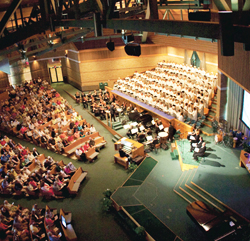“How do I get the biggest change in my sound quality for the smallest investment?”
I’m often asked this question from cash-strapped churches that need a sound system upgrade but don’t have the funds to accomplish it all at once.
If it’s the sound operator who approaches me first, his goal is usually to get a new mixing board. If it’s the worship leader, he’s usually focused on microphones and/or monitors.
Then there’s the pastor, who’s most often interested in the solution that will get everybody else to stop bothering him.
So what’s the answer?
I go about solving this dilemma by looking at the number of people who can potentially benefit from each upgrade. With that in mind, what follows is a suggestion of how you can determine your next “best” upgrade.
First, look at what I call the “heart” of the system. That is, loudspeakers, amplifiers and signal processing. Not only are these usually the biggest ticket items (though the mixing console may compete), they’re also the items that in most cases will bring the most significant improvement to a system.
In surveying the heart of your sound system, first check out the loudspeakers to ensure that they’re working properly. Are there blown drivers? Hear any rattles or other strange noises?
Do some research to find out the coverage pattern of the loudspeakers, and map that coverage over your seating area. Is the coverage adequate or are there zones that are being missed? (You can also hear this by slowly walking through the coverage area with the system playing tracks.)
Continue your research and determine the frequency response of the loudspeakers. If they roll off at 180 Hz, it’s not likely that they’re producing the nice “thump” out of the kick drum or any of the deeper lows from the bass guitar.
Next, find out power handling of the loudspeakers and match that up with the power available from your amplifiers. If you don’t have enough “headroom” (available “extra” power), the system will always sound mushy and like it’s being “pushed.” (As in pushed too hard.)
Finally, give the signal processing a good look. If it consists of a number of analog devices (EQ, crossover, delay, etc.), it could be time to upgrade to a quality digital processing unit. Even better, have a new digital processor implemented by a qualified professional who knows how best to use it to maximize the performance of your loudspeakers.
And that leads me to an important point. If you find any of the above aspects lacking during your research, consider bringing in a qualified professional to help make the most of what you have.
While you may be able to address some of these aspects adequately, it’s not a game for amateurs. Quite often, the use of professional assistance, combined with a new component or two, can make all of the difference in the world while still fitting within the confines of a tight budget. And it’s almost always money well spent.
Once the “heart” of the system is taken care of, feel free to move on to mixing boards, monitors, microphones and other accessories.
I look at it this way: the best sounding microphone is only going to sound as good as the loudspeakers reinforcing it.
Gary Zandstra is a professional AV systems integrator with Parkway Electric and has been involved with sound at his church for more than 30 years.



















